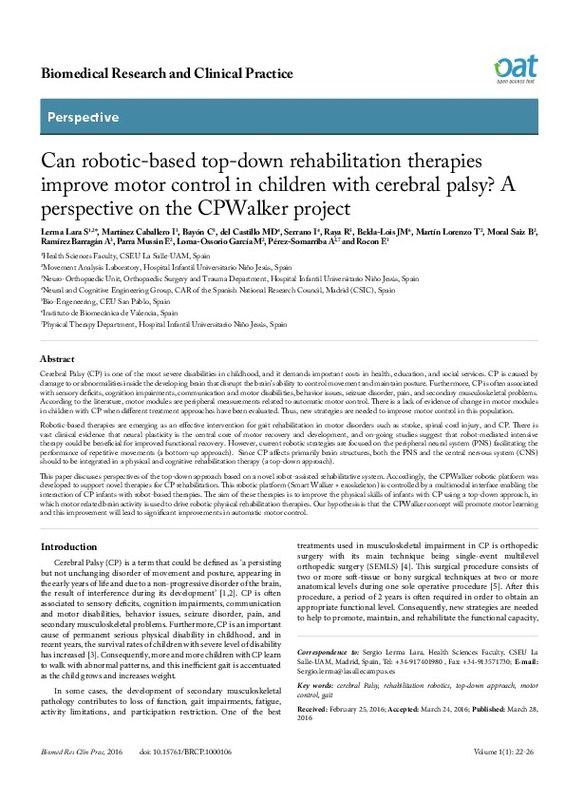JavaScript is disabled for your browser. Some features of this site may not work without it.
Buscar en RiuNet
Listar
Mi cuenta
Estadísticas
Ayuda RiuNet
Admin. UPV
Can robotic-based top-down rehabilitation therapies improve motor control in children with cerebral palsy? A perspective on the CPWalker project
Mostrar el registro sencillo del ítem
Ficheros en el ítem
| dc.contributor.author | Lerma Lara, S
|
es_ES |
| dc.contributor.author | Martínez Caballero, I
|
es_ES |
| dc.contributor.author | Bayón, C.
|
es_ES |
| dc.contributor.author | del Castillo, MD
|
es_ES |
| dc.contributor.author | Serrano, I
|
es_ES |
| dc.contributor.author | Raya, R.
|
es_ES |
| dc.contributor.author | Belda Lois, Juan Manuel
|
es_ES |
| dc.contributor.author | Martín Lorenzo, T.
|
es_ES |
| dc.contributor.author | Moral Saiz, B.
|
es_ES |
| dc.contributor.author | Ramírez Barragán, A.
|
es_ES |
| dc.contributor.author | Parra Mussin, E.
|
es_ES |
| dc.contributor.author | Loma-Ossorio García, M.
|
es_ES |
| dc.contributor.author | Pérez-Somarriba, A.
|
es_ES |
| dc.contributor.author | Rocon, E.
|
es_ES |
| dc.date.accessioned | 2017-12-04T10:54:39Z | |
| dc.date.available | 2017-12-04T10:54:39Z | |
| dc.date.issued | 2016 | es_ES |
| dc.identifier.issn | 2397-9631 | es_ES |
| dc.identifier.uri | http://hdl.handle.net/10251/91916 | |
| dc.description.abstract | [EN] Cerebral Palsy (CP) is one of the most severe disabilities in childhood, and it demands important costs in health, education, and social services. CP is caused by damage to or abnormalities inside the developing brain that disrupt the brain's ability to control movement and maintain posture. Furthermore, CP is often associated with sensory deficits, cognition impairments, communication and motor disabilities, behavior issues, seizure disorder, pain, and secondary musculoskeletal problems. According to the literature, motor modules are peripheral measurements related to automatic motor control. There is a lack of evidence of change in motor modules in children with CP when different treatment approaches have been evaluated. Thus, new strategies are needed to improve motor control in this population. Robotic-based therapies are emerging as an effective intervention for gait rehabilitation in motor disorders such as stroke, spinal cord injury, and CP. There is vast clinical evidence that neural plasticity is the central core of motor recovery and development, and on-going studies suggest that robot-mediated intensive therapy could be beneficial for improved functional recovery. However, current robotic strategies are focused on the peripheral neural system (PNS) facilitating the performance of repetitive movements (a bottom-up approach). Since CP affects primarily brain structures, both the PNS and the central nervous system (CNS) should to be integrated in a physical and cognitive rehabilitation therapy (a top-down approach). This paper discusses perspectives of the top-down approach based on a novel robot-assisted rehabilitative system. Accordingly, the CPWalker robotic platform was developed to support novel therapies for CP rehabilitation. This robotic platform (Smart Walker + exoskeleton) is controlled by a multimodal interface enabling the interaction of CP infants with robot-based therapies. The aim of these therapies is to improve the physical skills of infants with CP using a top-down approach, in which motor related brain activity is used to drive robotic physical rehabilitation therapies. Our hypothesis is that the CPWalker concept will promote motor learning and this improvement will lead to significant improvements in automatic motor control. | es_ES |
| dc.language | Inglés | es_ES |
| dc.publisher | Open Access Text | es_ES |
| dc.relation.ispartof | Biomedical Research and Clinical Practice | es_ES |
| dc.rights | Reconocimiento (by) | es_ES |
| dc.subject | Cerebral Palsy | es_ES |
| dc.subject | Rehabilitation robotics | es_ES |
| dc.subject | Top-down approach | es_ES |
| dc.subject | Motor control | es_ES |
| dc.subject | Gait | es_ES |
| dc.subject.classification | INGENIERIA MECANICA | es_ES |
| dc.title | Can robotic-based top-down rehabilitation therapies improve motor control in children with cerebral palsy? A perspective on the CPWalker project | es_ES |
| dc.type | Artículo | es_ES |
| dc.identifier.doi | 10.15761/BRCP.1000106 | es_ES |
| dc.rights.accessRights | Abierto | es_ES |
| dc.contributor.affiliation | Universitat Politècnica de València. Departamento de Ingeniería Mecánica y de Materiales - Departament d'Enginyeria Mecànica i de Materials | es_ES |
| dc.description.bibliographicCitation | Lerma Lara, S.; Martínez Caballero, I.; Bayón, C.; Del Castillo, M.; Serrano, I.; Raya, R.; Belda Lois, JM.... (2016). Can robotic-based top-down rehabilitation therapies improve motor control in children with cerebral palsy? A perspective on the CPWalker project. Biomedical Research and Clinical Practice. 22-26. doi:10.15761/BRCP.1000106 | es_ES |
| dc.description.accrualMethod | S | es_ES |
| dc.relation.publisherversion | https://doi.org/10.15761/BRCP.1000106 | es_ES |
| dc.description.upvformatpinicio | 22 | es_ES |
| dc.description.upvformatpfin | 26 | es_ES |
| dc.type.version | info:eu-repo/semantics/publishedVersion | es_ES |
| dc.relation.pasarela | S\336051 | es_ES |








